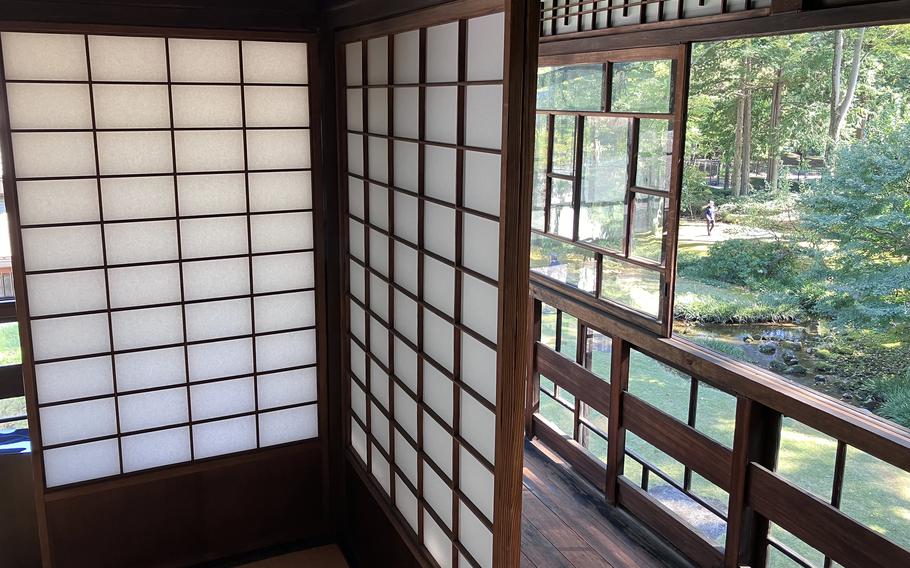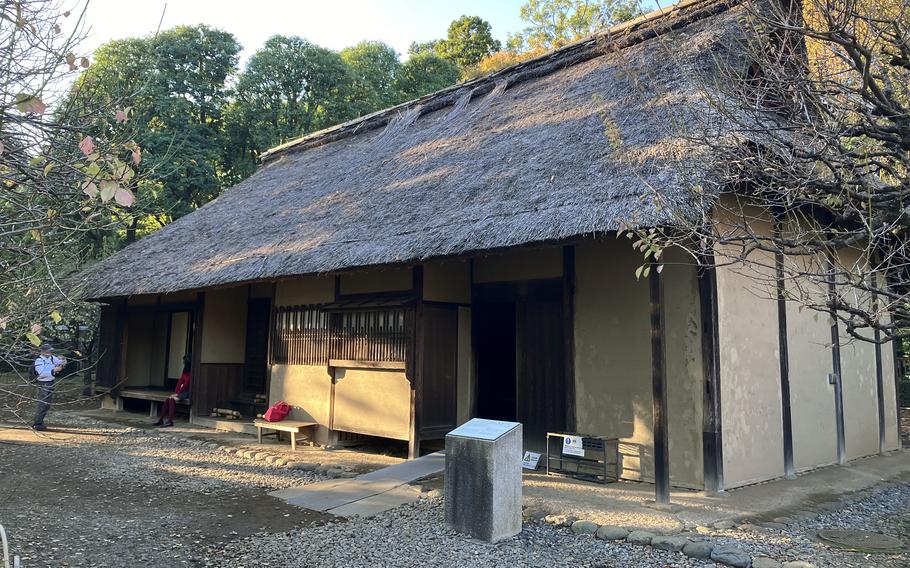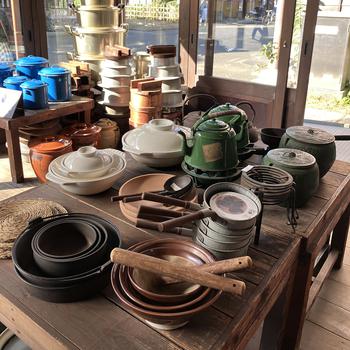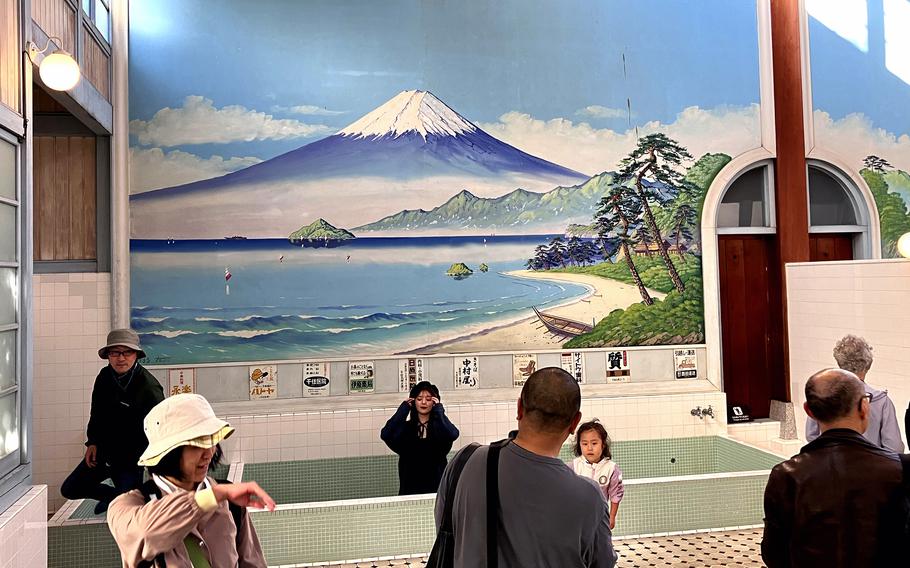
The view from the second floor at the House of Korekiyo Takahashi at the Edo-Tokyo Open Air Architectural Museum in Koganei, Japan. (Joseph Ditzler/Stars and Stripes)
The Edo-Tokyo Open Air Architectural Museum is an experience both subtle and sublime, a park within a park and more fun than a museum should be.
Now that summer has loosened its torrid grip, a trip to this outdoor museum in the western Tokyo suburbs is a perfect way to spend a fall afternoon, immersed in Japanese material culture and the Edo, Meiji and Showa eras of Japanese history, encompassing the mid-19th to the early 20th centuries.
The museum has gathered more than two dozen structures, ranging from simple farmhouses to an industrialist’s mansion, and arranged them in a 17-acre compound inside Koganei Park in Koganei city.
Some of the structures are historic, including a mausoleum to a shogun’s concubine and the home of a government minister who was assassinated on the building’s second floor.
Anyone who savors Japanese building styles — tatami floors, paper screens and dark, heavy beams beneath thatched roofs — will be right at home. Many structures also reflect the Western influence that permeated Japan after the Meiji Restoration. For the uninitiated, the outdoor museum is an opportunity to experience these things at a leisurely pace.
The Hachioji-sennin-doshin, or House of the Leader of the Hachioji Guards, is a grand title for a humble, one-story, thatched-roof home. The house was occupied by the guard chief of the Tokugawa Shogunate, the dynastic regime that ruled Japan from 1603 until 1868.
The structure is Zen-like in its simplicity. It’s little more than a cottage with an earthen floor in the food preparation and storage area, a common feature of rural homes. But it is distinguished by its tatami floors, simple beam construction and shikidai, a wooden step in the entrance hall that signifies an occupant of some standing.

The House of the Leader of the Hachioji Guards is a modest rural cottage at the Edo-Tokyo Open Air Architectural Museum at Koganei, Japan. (Joseph Ditzler/Stars and Stripes)
The guard chief’s home occupies a spot on the museum’s west end with two farmhouses and a granary.
Nearby is the relocated home of Takakimi Mitsui, the head of the Mitsui conglomerate, or zaibatsu, a family-owned corporate trust. Mitsui and other zaibatsu played instrumental roles in moving Japan rapidly to an industrial powerhouse in the late 19th and early 20th centuries. They were dismantled after World War II, but their corporate descendants survive today. Mitsui devolved into banking, insurance, chemicals and other entities.
The impressive Mitsui home is under renovation, unfortunately, until March.
Nearby is the modest home of Korekiyo Takahashi, a former prime minister of Japan and at the time of his death in February 1936 the finance minister. He advocated for cuts in military spending that piqued the young, nationalistic army officers who killed Takahashi in his sleep during a wider uprising. Korekiyo was the last former prime minister assassinated in Japan until Shinzo Abe’s killing in 2022.

Stacks of houseware on display inside a shop at the Edo-Tokyo Open Air Architectural Museum in Koganei, Japan. (Joseph Ditzler/Stars and Stripes)
On the east side of the museum park stands a re-created commercial street, including shops for kitchenware, cosmetics, groceries and soy. In the stationery shop, uniform boxes of writing materials are stacked on shelves alongside arrays of brushes of varying widths for the art of Japanese calligraphy, or shodo. The interior carries the quiet mystique of a library.
Across the way stands the House of Uemara, built with Western influences and covered with copper sheeting that shows nicks and dents from World War II aerial bombardment at its original location in the heart of Tokyo.
Each property in the museum is accessible and invites careful inspection, from the 1920s-era home that looks like a transplant from Connecticut to the cramped neighborhood bar, the umbrella shop and the public baths. Some sites require you to remove your shoes, but not all; particularly the commercial buildings.

The public bathhouse at the Edo-Tokyo Open Air Architectural Museum in Kogenei, Japan, is a centerpiece building that resembles a temple from the outside. (Joseph Ditzler/Stars and Stripes)
Most of the former homes are surrounded with landscaped gardens with a soundtrack provided by gurgling streams and arrayed with a variety of native plants, many marked for identification.
The Koganei Park surrounding the museum is a huge acreage full of families gathered on weekends to toss Frisbees, play catch or simply relax in the sun. At the heart of the park is a large slide and rope-swing complex as busy as an anthill.
On the QT
Directions: Address: Edo-Tokyo Open Air Architectural Museum, 3-7-1 Sakuracho, Koganei, Tokyo 184-005 (in Koganei Park); by train to Musashi-Koganei Station, exit the Central Gate and look for the bus stop across the street with a banner overhead indicating the bus for the museum, or a 30-minute walk north along urban Route 15.
Times: Open every day except Monday (or the Tuesday following Monday holidays), 9:30 a.m. to 5:30 p.m. April to September and until 4:30 p.m. October to March.
Costs: Admission 400 yen ($2.64) adults; 200 yen 65 and older; discounts for students and groups; junior high and primary school children admitted free.
Food: The Georg de la Lande House is a restaurant with curry rice, drinks and tasty desserts; the Old Warehouse features udon and other selections; refreshment stands dot Koganei Park.
Information: Phone: 042-388-3300; online: tatemonoen.jp/english